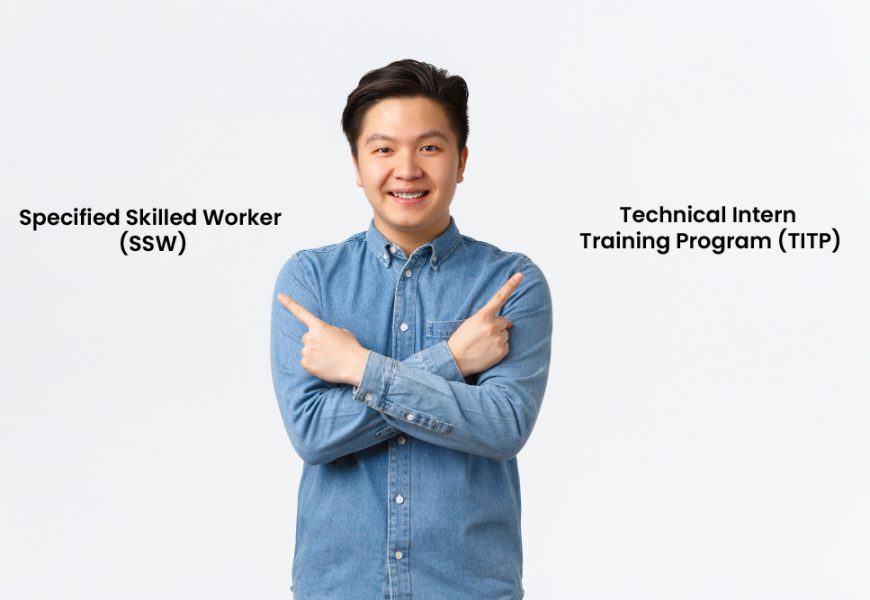In Japan, both programs, Specified Skilled Worker (SSW) and Technical Intern Training Program (TITP) are available for individuals applying for a working visa in Japan.
Differences between TITP and SSW:
Purpose
Technical Intern Training program is only designed to transfer skills to and provide technical aid for the development of growing nations. Whereas the Specific Skilled Worker program is to call for a foreign professional to solve the workforce shortage in Japan.
Industry and Occupation
For any industry, both Specified Skilled Workers and Technical Intern Trainees are eligible based on skill level. For example, technical interns and skilled workers can apply for agricultural jobs but they will be paid differently.
Job Switch
Only Specified Skilled Workers are permitted to switch jobs in the same industry or other fields depending upon the recognised skill set by that institution. Technical Intern Training Program does not allow individuals to change to another job except for cases like bankruptcy or the destruction of the company due to natural disasters.
Family Sponsorship
For TITP participants and Specified Skilled Worker type (1), they are not allowed to bring their family members with them under any circumstances. Whereas, for Specified Skilled Worker type (2) visa holders can invite their spouse and children to live in Japan.
Parties Involved
In the Technical Intern Training Program, there are five parties involved to send one participant to Japan: the foreign worker, the dispatching company, transferring company overseas, the supervisor organization, and registering and accepting company.
For Specified Skilled Workers, (1) & (2), only one party is involved, mainly through accepting the organization providing an employment contract.
Specified Skilled Worker
Specified Skilled Worker (SSW) or “Tokutei Ginou” is a designation given to foreigners who, for work opportunities, pass immigration as well as proficiency tests for specific jobs in Japan. There are two types of Specified Skill Workers: SSW (1) for considerably skilled professionals and SSW (2) for proficiently skilled professionals.
Technical Intern Training
Technical Intern Training Program (TITP) or “Ginou Jisshu”, started in 1993, is a beneficiary program that helps developing countries and their citizens to transfer skills through On-the-Job training (OJT) in Japan. It aims to strengthen international bonds through an exchange of skills, techniques, and knowledge given to technical interns coming from developing nations.
Overview Of Specified Skilled Worker (SSW)
Introduced in April 2019, the Japanese government initiated a new status of residence for foreign workers called Specified Skilled Worker (SSW). It aims to provide support and resolve the labour shortage in Japan by giving foreign workers residence status in the country based on their skill set. Japan plans to hire about 345,000 non-native workers under the work visa status in 5 years (till 2024).
Under the Specified Skilled Worker program, there are two categories set to distinguish between proficient skilled (type 2) and adequately skilled (type 1). Type 1 allows a maximum stay of 5 years with no benefits, while Type 2 work visa can lead to permanent residency with unlimited renewals and is only applicable for individuals selected for construction, shipbuilding, and ship machinery industry.
Why was it started?
After the decline of the labour force in Japan for the last five years, the Japanese government decided to migrate skilled workers from various foreign countries to support and complete their labour needs. From the nursing industry to aviating industry, there are several work opportunities for foreigners in exchange for good pay, a visa limit of five years and a chance for a Specified Skill Worker (type 2) to obtain permanent residency.
How does it work?
To get a work visa in Japan under a Specified Skilled Worker (type 1), you need to pass the Japanese Language Proficiency Test (JLPT) and a skill proficiency test. Upon checking your results, an organization looking for applicants in their related field will provide a contract to you. After signing the contract, you are eligible to apply for your Specified Skilled Worker Status of residence.
What impact has it had?
By providing an optimistic and attractive opportunity for foreign workers, Japan has enabled a stream of human resources to enter the country and support their systems in exchange of:
- Long-term employment for Specified Skilled Workers (type 2)
- Permanent Residency offer for long-term employees and a way to invite their spouse and children to Japan.
- The salary of SSW is equal to or higher than native workers performing the same tasks with the allowance of ten days paid leave.
- Only Specified Skilled Workers are given the freedom to switch jobs in Japan, other than the native population.
Job Categories Under SSW
There are two types of Specified Skilled Workers: Type 1 and Type 2
Employment fields under Specified Skilled Worker Type 1:
- Nursing – providing assistance to people with physical disabilities
- Building cleaning management – cleaning inside buildings
- Machine parts and tooling industries – creating components etc.
- Industrial machine industry – creating components etc.
- Electrics, electronics and information industries- creating components etc.
- Automobile repair and maintenance- inspecting and maintaining automobiles
- Aviation industry – transporting baggage in airplanes’ inspecting and maintaining airplanes
- Accommodation industry- Working at hotel receptions and greeting guests
- Agriculture- growing and harvesting vegetables and other produce. Raising pigs, cattles, chickens and other animals
- Fishery and Aquaculture industry – catching and raising fish
- Manufacture of food and beverages- preparing food
- Food services industry – Waiters
Employment fields Specified Skilled Worker Type 2:
- Construction industry – constructing houses, buildings and other structures
- Shipbuilding and ship machinery industry – building ships
Overview Of Technical Intern Training Program (TITP)
Signed on October 17, 2017, the Memorandum of Cooperation (MoC) with the Ministry of Justice, Ministry of Foreign Affairs, and Ministry of Health of Japan initiated several measures to amplify the efforts of the Ministry of Skill Development and Entrepreneurship to make India the skill capital of the world.
The Technical Intern Training Program (TITP) targets to contribute their technical knowledge to boost the technical skills of the citizens of developing nations. By implementing education and transfer of skills through On-the-Job Training (OJT) in Japan, the Japanese government is inviting people from all over the world to work and support their labour system with a visa limit of 3-5 years.
Why was it started?
Starting in 2019, the program offers selected candidates from India a 3-5 year internship in Japan for specific industries. After the completion of the course, the candidates are required to return and integrate learned skills in the direction of developing India.
How does it work?
To be selected and transferred to Japan under TITP, one must conform to these points:
- Recruitment – Applicants that are considered for the jobs are registered under the training program.
- Japanese language and culture training – Recruited individuals are trained for 3-4 months in their culture and taught their language.
- Interview: After the training, people are interviewed by Japanese companies looking to hire.
- Medical Examination: Selected individuals undergo a medical examination to screen out people with medical conditions.
- Deployment and Employment – After the visa has arrived, the sending organization deploys selected participants to Japan, where they are accommodated near the accepting organization.
- Return to India: After the training period of 3-5 years, they are sent back to India.
What impact has it had?
During 3-5 years, the Technical Intern Training Program offers a good list of benefits, as stated below:
- Social security including medical insurance, pension, bonus, and more.
- High pay with an average salary of 100000-150000 INR per month with a projection of 30 lakh earnings in 5 years.
- With learnt skills and an understanding of advanced systems in Japan, individuals are hired to perform in-demand skill jobs around the globe.
- Around 424 Indian interns were sent to Japan in August 2022.
Job Categories Under TITP
Under the Technical Intern Training Program, the interns are hired by industries as stated below:
- Automobile Sector (19.8%)
- Agriculture (3.1%)
- Textile (0.7%)
- Food Manufacturing (0.5%)
- Construction (9.0%)
- Care Worker (21.5%)
- Machinery (36.3%)
- Others (9.2%)
Which one would you choose – TITP or SSW?
From the objective perspective, it is always essential to first recognize personal skillset level by giving the Japanese Language Proficiency Test and the skill proficiency test. The test results will present a realistic perspective for the consideration of the Specified Skilled Worker residence status.
Individuals who are unaware but are willing to work in Japan should apply for the Technical Intern Training Program as it will guide them seamlessly into the Japanese workforce with a work visa of 3-5 years and good benefits.




